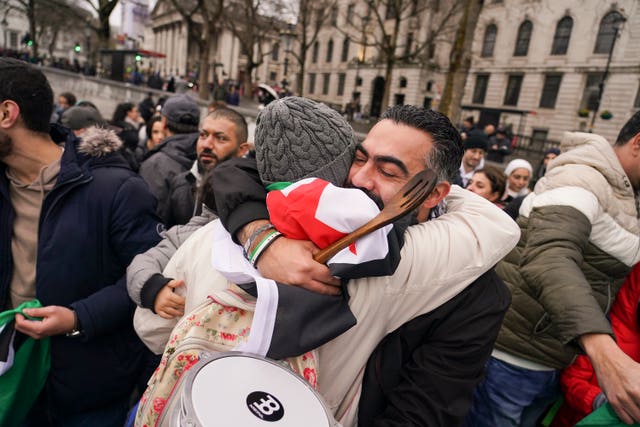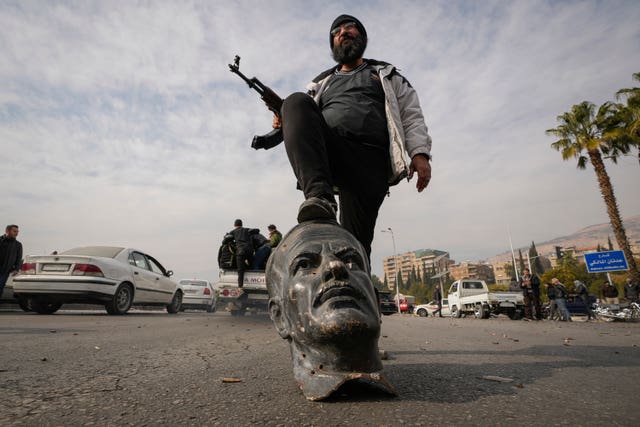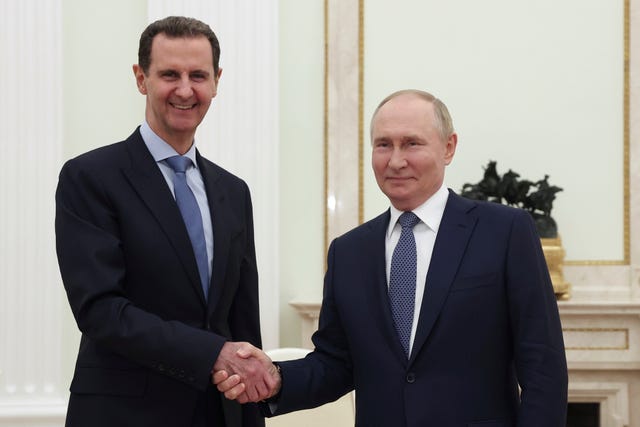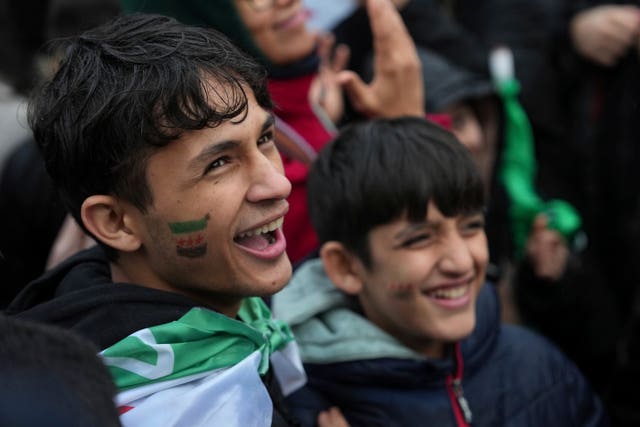
Clare Foges 6pm - 9pm
8 December 2024, 15:24 | Updated: 9 December 2024, 07:52

The Assad family’s 50-year, often brutal rule of Syria is over.
The Assad family’s 50-year, often brutal rule of Syria is over after a lightning rebel advance reached the capital Damascus in the early hours of Sunday.
President Bashar Assad and other top officials vanished, their whereabouts unknown, as joyful crowds gathered in central squares to celebrate their downfall.
Here is a timeline of key events in Syria since Mr Assad’s move to crush a pro-democracy uprising resulted in civil war:
– 2011
March: Protests erupt in the city of Daraa over the detention of a group of boys accused of painting anti-government graffiti on their school walls.
On March 18, security forces fire at a protest in Daraa, killing four people in what activists say were the first deaths of the uprising.
Demonstrations spread, as does the crackdown.
April: Security forces raid a sit-in in Syria’s third-largest city, Homs, where thousands tried to recreate the mood of Cairo’s Tahrir Square, the epicentre of protests against Egyptian autocrat Hosni Mubarak.
– 2012
July 18: A bombing at the Syrian national security building in Damascus during a high-level government crisis meeting kills four top officials, including Mr Assad’s brother-in-law and the defence minister.
Fighting spreads to Aleppo, Syria’s largest city and commercial capital.
– 2013
Syria’s government and opposition trade accusations over a gas attack that killed 26 people, including more than a dozen soldiers, in the northern town of Khan al-Assal.
A UN investigation later finds sarin nerve gas was used, but does not identify a culprit.
May: Lebanon’s militant Hezbollah group officially joins the Syrian conflict on Mr Assad’s side.
August 21: A chemical attack in Damascus’s eastern Ghouta suburbs kills hundreds. The US and others blame Syrian government forces.
September 27: The UN Security Council orders Syria to account for and destroy its chemical weapons stockpile, following a surprise deal between Washington and Moscow that averts US strikes.
October 14: Syria becomes a signatory to the Chemical Weapons Convention, prohibiting it from producing, stockpiling or using chemical weapons.

– 2014
June 23: The Organisation for the Prohibition of Chemical Weapons says it has removed the last of the Syrian government’s chemical weapons.
June 30: Islamic State declares its so-called caliphate in areas it controls in Iraq and Syria.
The refugee crisis accelerates.
September 23: The US launches air strikes on IS targets in Syria.
– 2015
March 28: Syria’s north-western city of Idlib falls to Islamic militants led by al-Qaeda’s affiliate known as the Nusra Front.
September 25: The body of three-year-old Alan Kurdi is found on a Turkish beach, drawing attention to the plight of Syrian refugees taking desperate risks to reach the safety of Europe.
September 30: Russia begins launching air strikes in Syria in support of Mr Assad’s forces.
– 2016
August: Turkish forces cross into northern Syria, capturing areas along the border from the Islamic State group.
December: Syrian insurgents pull out of rebel-held eastern neighbourhoods of the northern city of Aleppo after a Russia-backed government offensive.

– 2017
April 4: At least 58 die in what doctors say may have been a nerve gas attack on the town of Khan Sheikhoun in rebel-held Idlib.
Witnesses say either Russian or Syrian Sukhoi jets carried out the attack. Moscow and Damascus deny responsibility. The US later fires a barrage of cruise missiles into Syria in retaliation for the Khan Sheikhoun attack, the first direct American assault on the Syrian government.
May: Rebels withdraw from the last neighbourhood they controlled in Homs, once dubbed the capital of the revolution.
– 2018
January 20: Turkey begins a major military operation against Syrian Kurdish fighters in northern enclave of Afrin.
April: Syrian government forces capture eastern Ghouta, taking control of all Damascus suburbs and securing Mr Assad’s seat of power.
April 14: The US, Britain and France launch military strikes in Syria to punish Mr Assad for an April 7 purported chemical weapons attack that activists say killed more than 40 people in the Damascus suburb of Douma.
– 2019
October 10: Turkey begins a ground offensive against Kurdish fighters in northern Syria after US troops pulled back from the area.

– 2020
March 5: The presidents of Russia and Turkey say they have reached agreement on a ceasefire in north-western Syria, where escalating fighting had threatened to put their forces into direct
conflict.
The truce also stopped a Russian-backed government offensive on Idlib, the last rebel stronghold.
2024
March: The civil war enters its 14th year, with observers saying violence is on the rise while the world’s attention is focused on other crises, such as Russia’s onslaught on Ukraine and the Israel-Hamas war in Gaza.
April: Israel demolishes Iran’s consulate in Damascus in an air strike, apparently signifying an escalation of its targeting of Iranian military officials and their allies. The attack killed General Ali Reza Zahdi, who led the elite Quds Force in Lebanon and Syria until 2016, according to Iran’s Revolutionary Guard.
Amnesty International says it has documented widespread abuses, including torture and deprivation of medical care, in detention facilities holding thousands of suspected Islamic State members and their relatives in north-east Syria.
As the year goes on, Israel steps up its attacks inside Syria, saying it is acting against military sites linked to Iran and Lebanese militant group Hezbollah.
October: A series of US air strikes target several camps run by Islamic State in Syria in an operation the American military said will disrupt the extremists from conducting attacks in the region and beyond.

November 27: Syrian armed groups launch a large-scale attack on areas controlled by government forces, setting off fierce clashes and seizing territory in western Aleppo.
November 29: Insurgents led by Hayat Tahrir al-Sham breach Aleppo and clash with government forces for the first time since 2016. They take the city the next day.
December 5: The Syrian army withdraws from the central city of Hama after insurgents break through its defences.
December 6: Insurgents enter the central towns of Rastan and Talbise, bringing them closer to Syria’s third largest city of Homs.
December 7: Opposition forces reach the outskirts of the capital Damascus, as government forces are said to have withdrawn from much of Homs.
December 8: The Syrian government of President Bashar Assad falls after the rebels’ stunning advance across the country. Mr Assad is said to have fled the country for an undisclosed location, as Syrians pour on to the streets to celebrate the end of the regime.